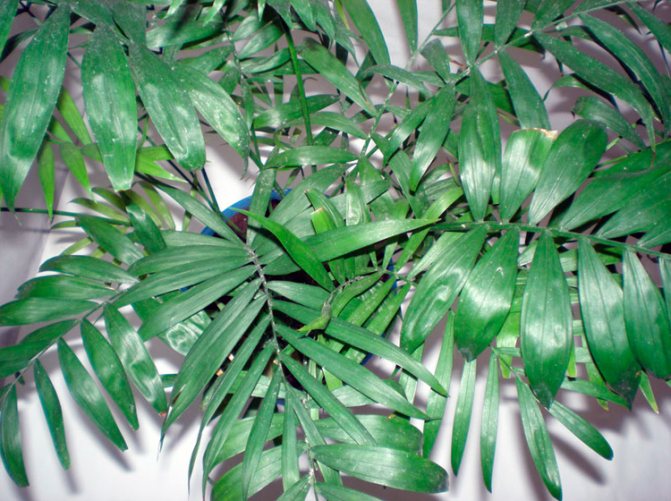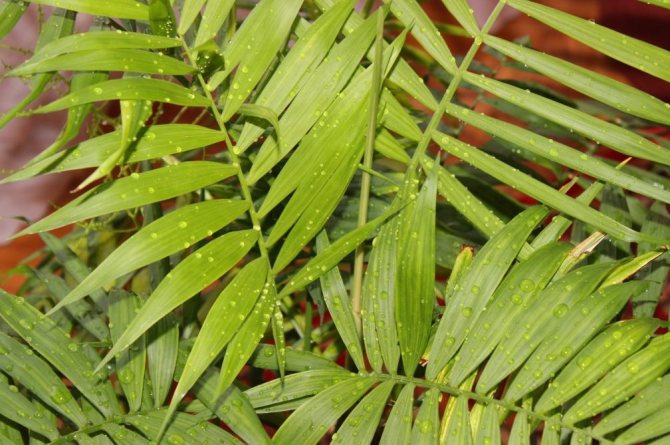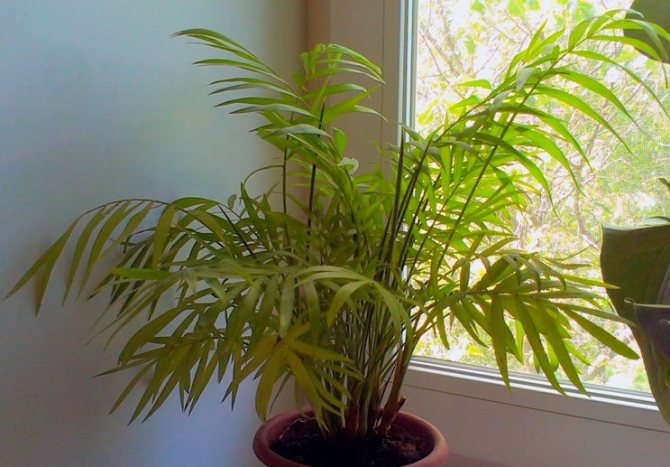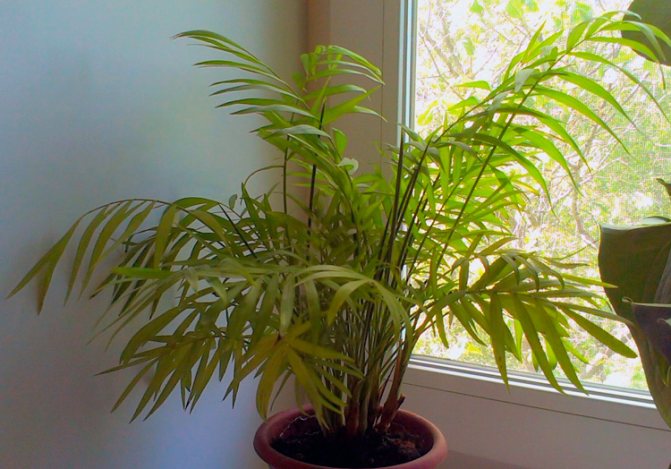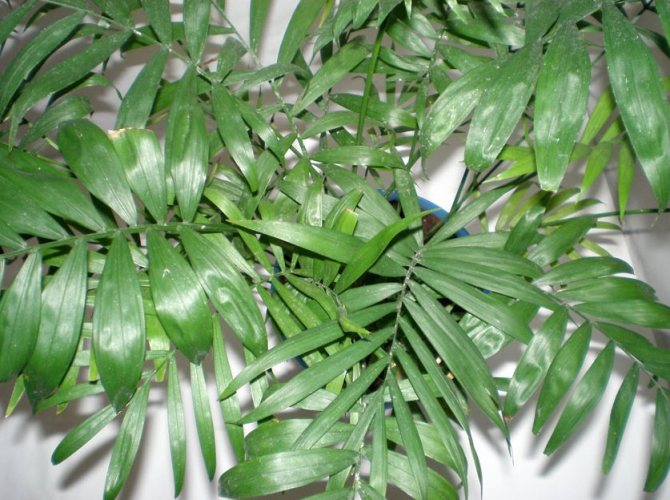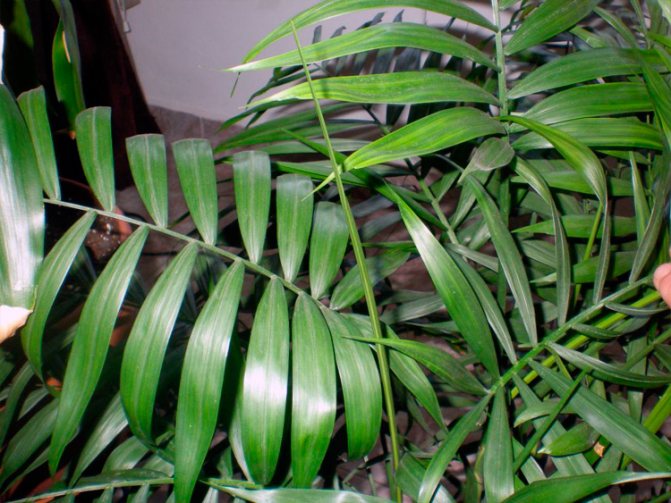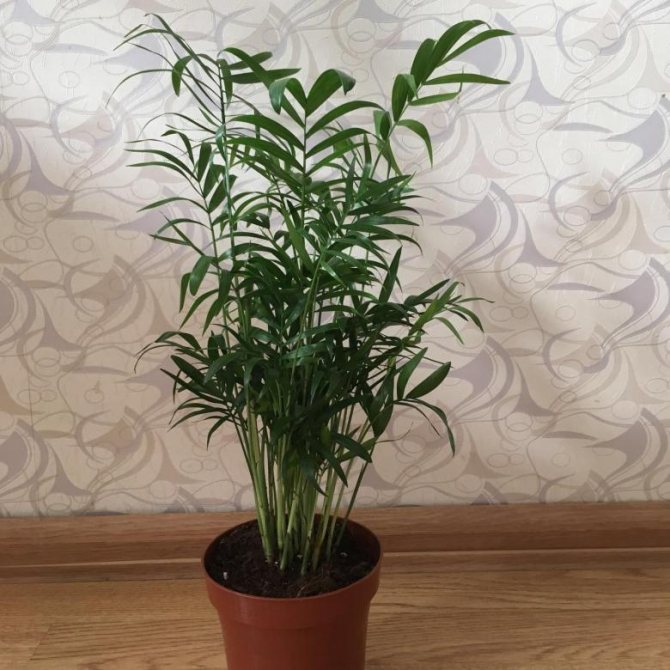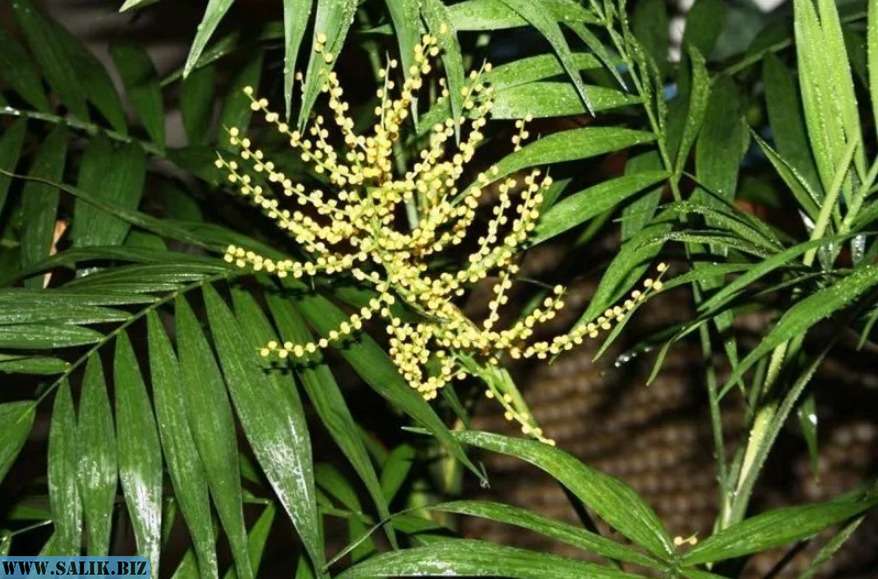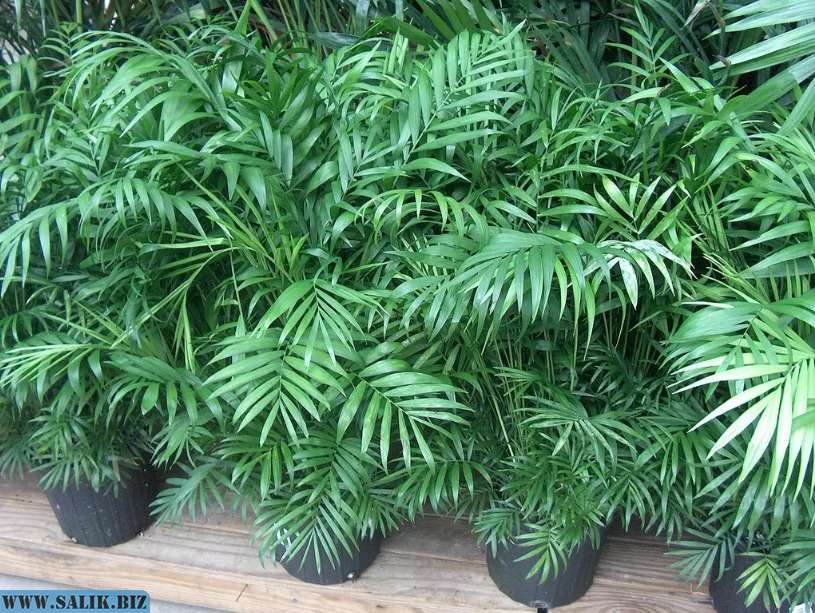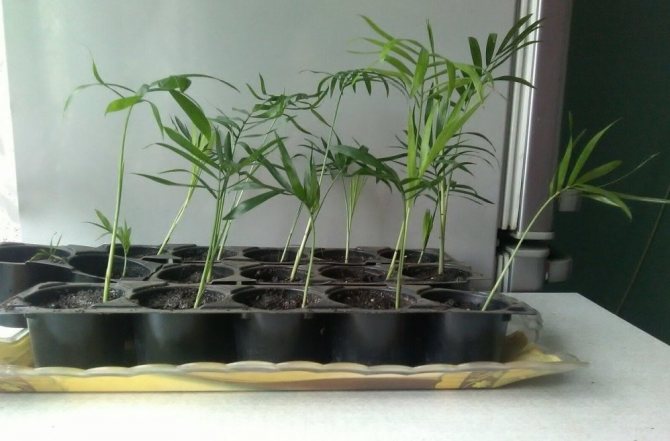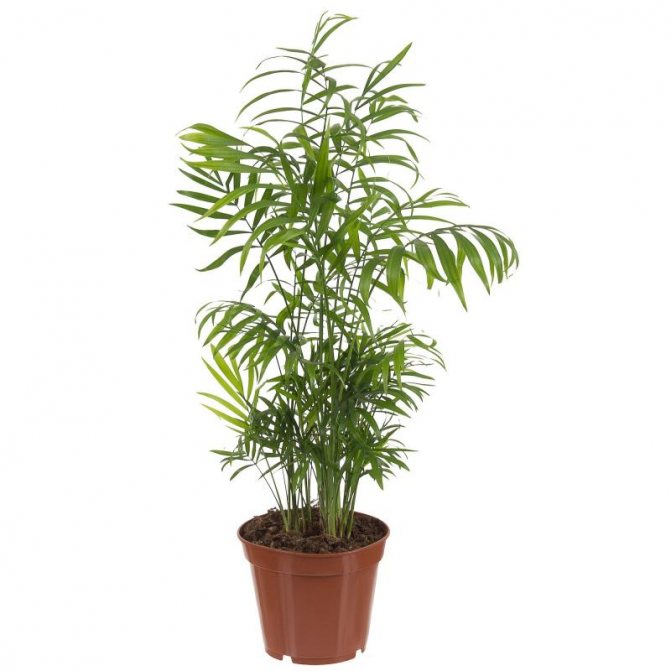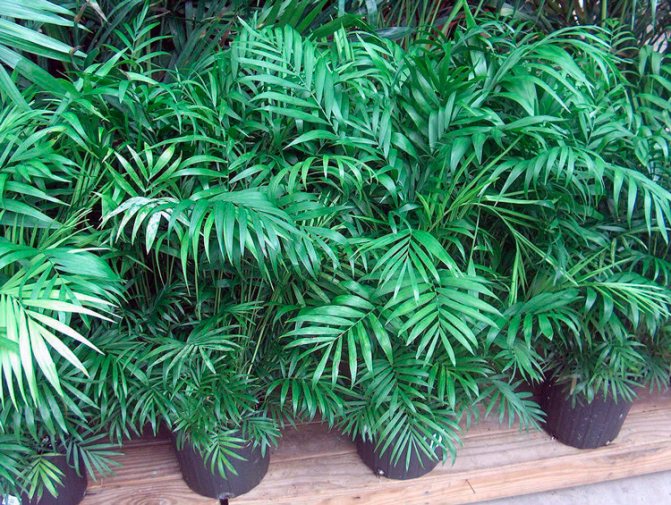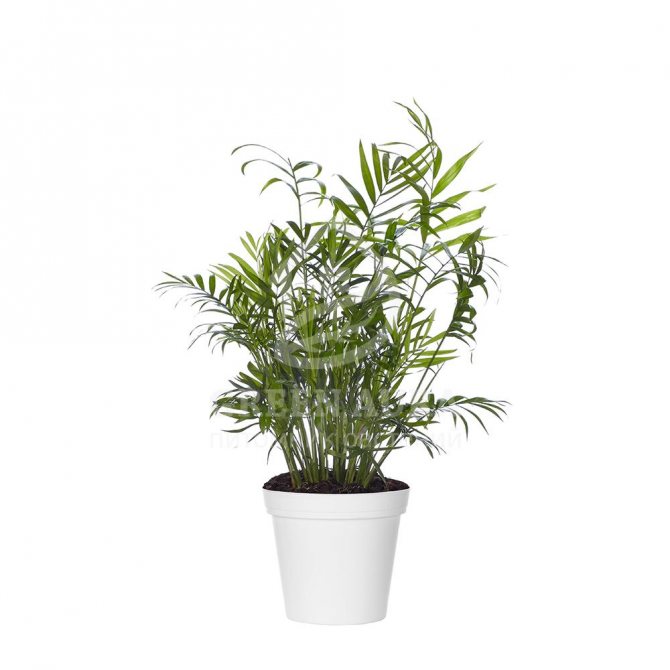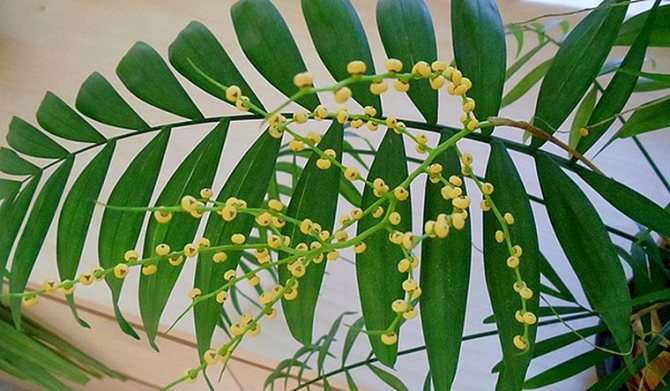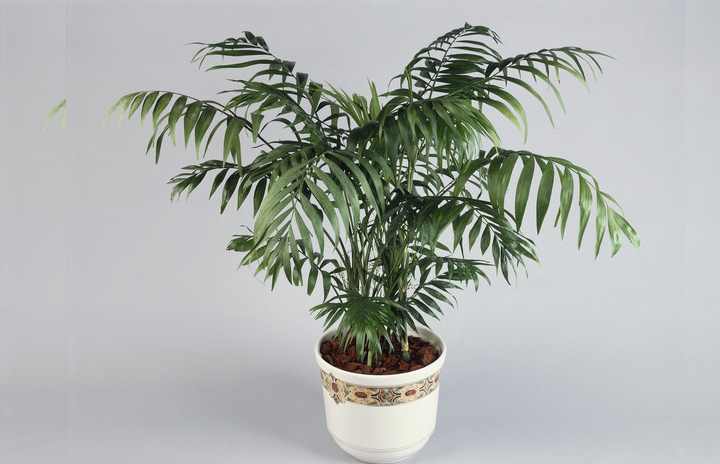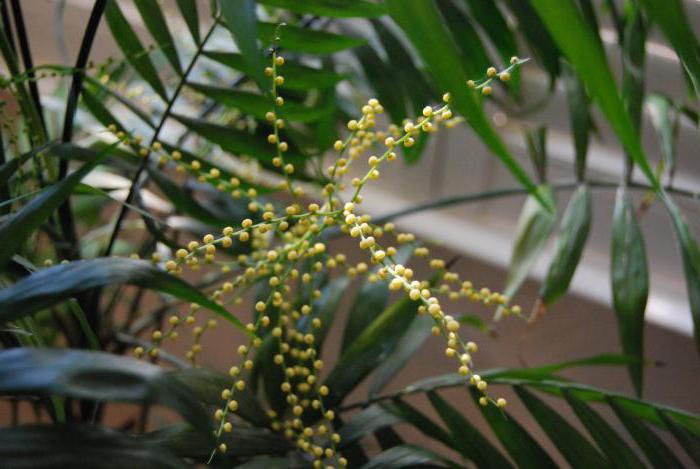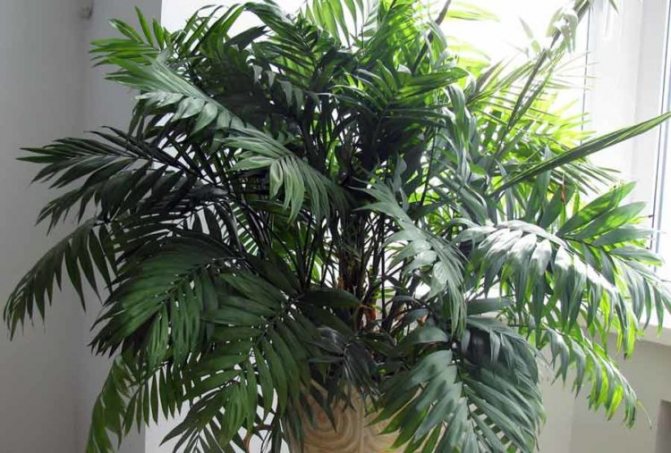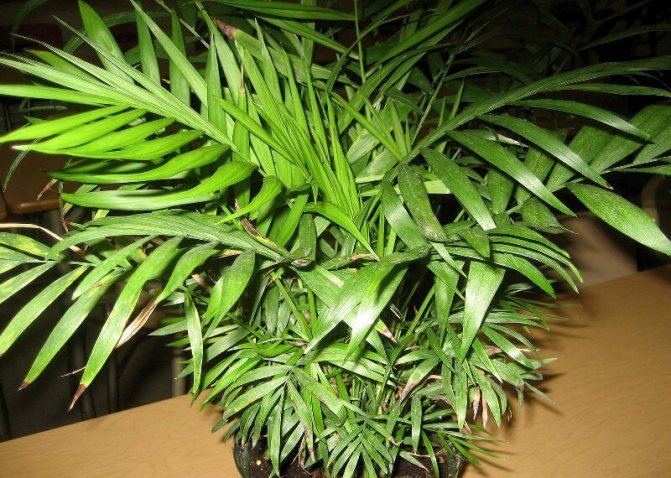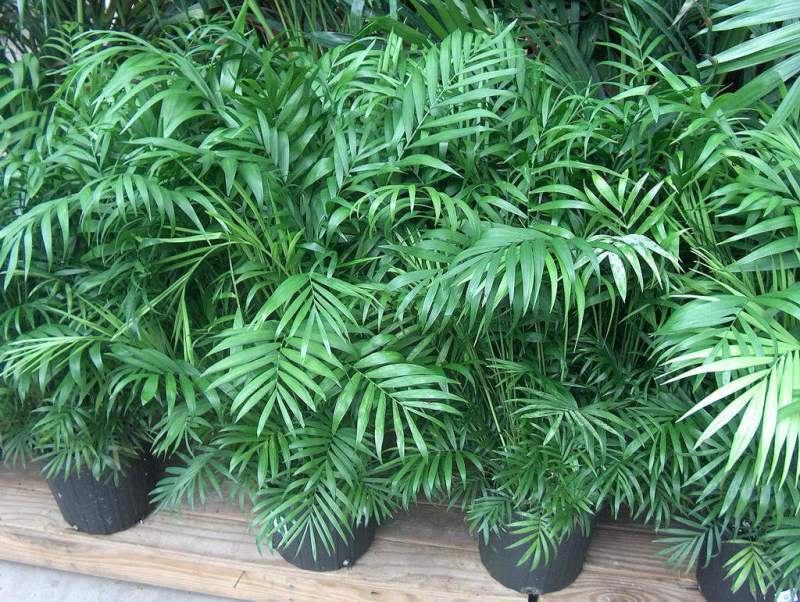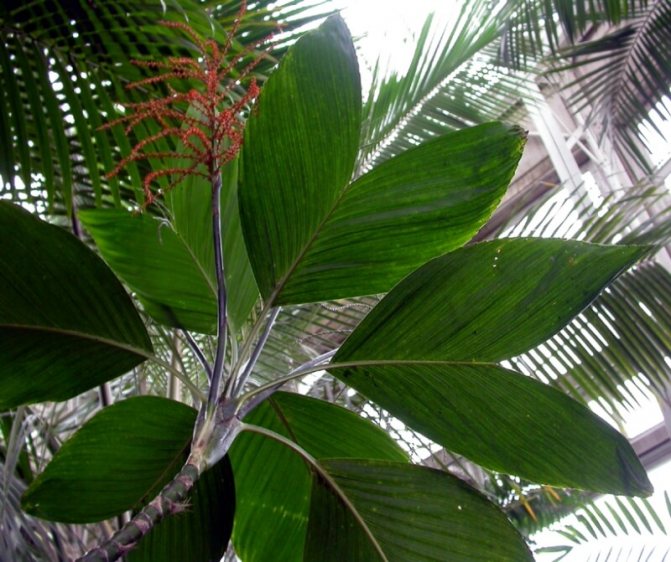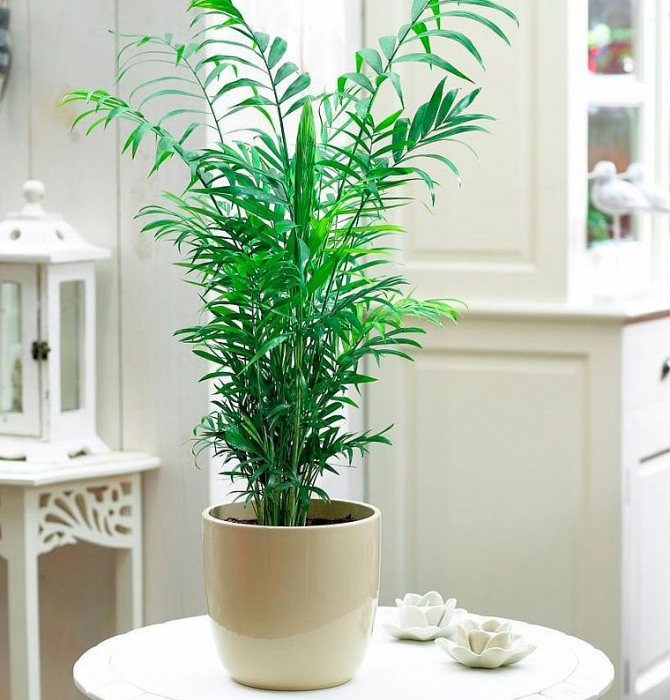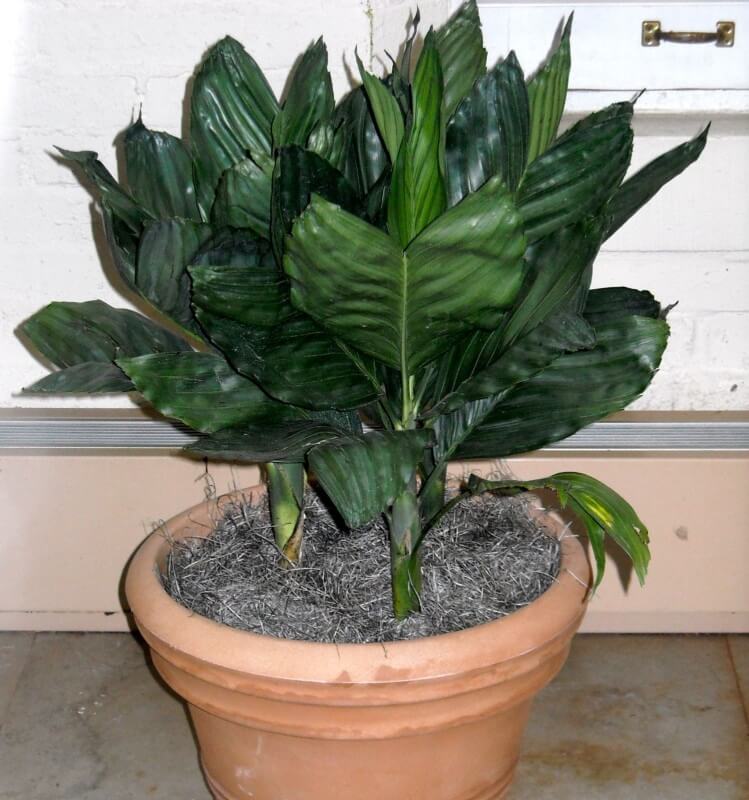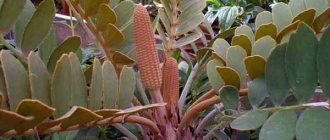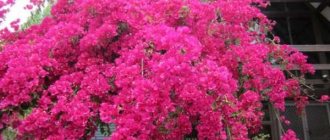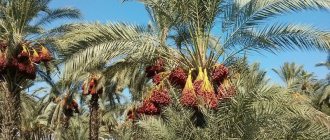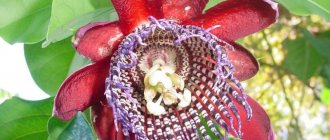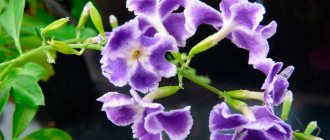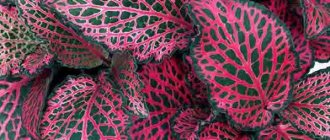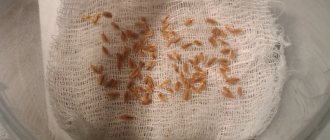Hamedorea Elegance (hamedorea graceful, neanta graceful, reed palm, bamboo palm, graceful colline) is a low, slow-growing palm tree native to the tropical rainforests of Mexico and Guatemala. The trunk is thin, green in a young plant, acquires a chestnut shade with age, grows up to 1.2 meters in a room culture (maximum height - up to 2 meters). The leaves are thin, compound, feathery, dark green. Hamedorea elegance begins to bloom at a young age (3-4 years): the flowers are small, yellow, fragrant, gathered in panicles, then dark berries the size of a pea are formed in their place.
Useful properties of hamedorea
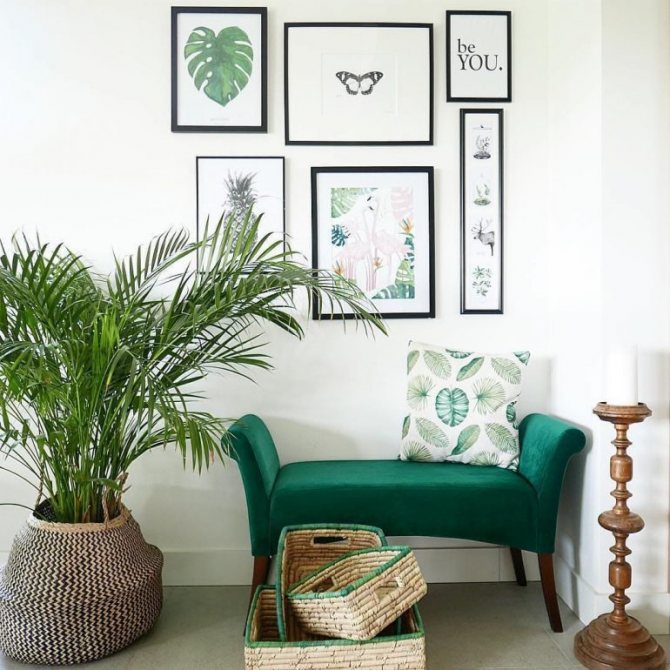
Photo
Exotic palm has beneficial properties - it is phytoncidoactive. In other words, the plant is capable of purifying the air in the room, and also effectively eliminates harmful fumes, for example, benzene, ammonia, formaldehyde and other volatile substances.


Hamedorea elegance. Photo
The benefits and harms of hamedorea elegance
Hamedorea elegance, despite its compactness, is spectacular, like all palm trees. It looks good in the interior of any apartment or office space - both as a tapeworm and in a group.
Hamedorea elegance is not only beautiful and unpretentious, but also useful. It is one of the plants that humidify the air and cleanse it of harmful impurities (benzene and formaldehyde). The plant is not poisonous, it is safe for pets.
Palm trees relieve pessimism and melancholy and create a cheerful mood, therefore the most successful place for hamedorea elegance in the house is the living room, and it is undesirable to place it in the bedroom.
Features of growing at home. Briefly
Like any plant, chamedorea at home requires certain conditions of maintenance and care. Basic rules for growing a palm tree:
| Temperature regime | 12-20˚С, does not tolerate too low and high temperatures. |
| Air humidity | Recommended around 50%, but tolerates low humidity. |
| Lighting | In summer, the soil should be constantly moist; in winter, watering is reduced. |
| Watering | Regular, plentiful after the topsoil dries. |
| Soil for palm | Substrate of 3 parts of sod land and 1 part of sand, peat, deciduous land. |
| Top dressing and fertilization | The universal fertilizer crushed in half with water is applied every 2-4 weeks. |
| Transfer | Annual transplantation is required for young plants, then every 3 years. |
| Reproduction | Seed method, by offspring, by dividing the bush. |
| Growing features | Requires shading, frequent watering. |
Difficulties in growing
All tropical plants when grown in the middle lane are characterized by increased demand for care. Therefore, it is not surprising that the slightest disturbance can adversely affect health, and hence the appearance of a palm tree.
The most common problems of florists in this case include:
- Yellowing and drying of the tips of the leaf plates, which is most often associated with dry indoor air. Try cutting off damaged parts and increasing the humidity.


- Decay of leaves at the level of the ground line. The cause of the problem also lies in the violation of the rules of care, only this time the humidity and the regularity of watering should not be increased, but, on the contrary, should be reduced.Do not forget to make sure that the temperature conditions are optimal for the plant, because in a cold room the leaves will not dry out quickly.
- The appearance of yellow spots on the leaves is a frequent result of prolonged exposure to direct sunlight. Find a new place for the palm tree. It is likely that her appearance will return to normal soon.
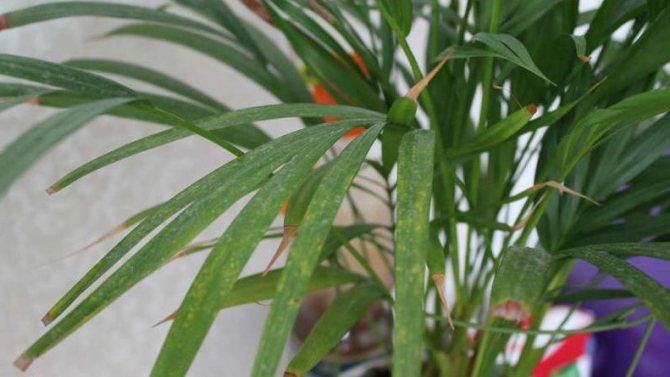

- Withering and twisting of leaf plates. The cause of this problem is often high temperatures. The plant is very hot and it is best to move it to a cooler room.
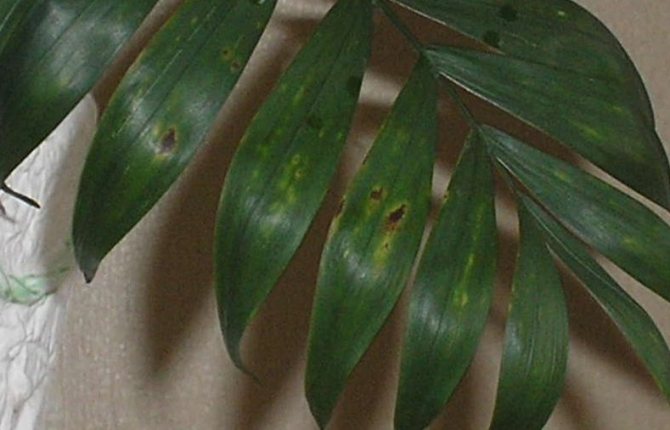

- Slowing down the growth of green mass. If the leaves grow very slowly and the palm looks bare, it may be lacking in nutrients, or the temperature in the room is too low (this is often the case in winter).
- The appearance of brown spots on the leaves sometimes occurs with a sharp change in temperature, as a result of a draft. Move the plant to a more protected area.
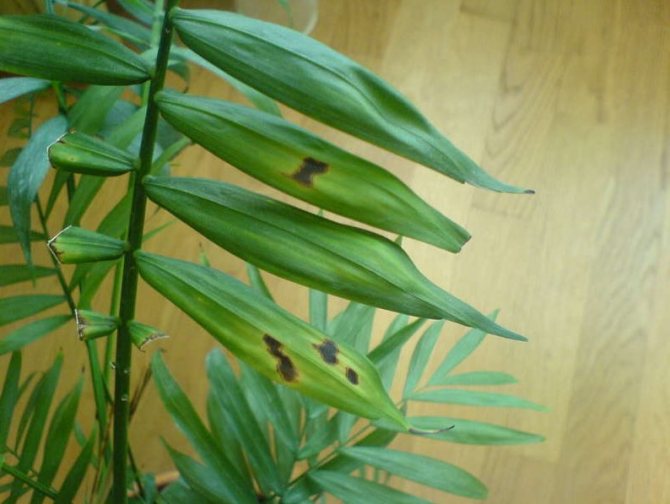

- Drying of young leaves is the result of decay of the root system of the plant, due to an excess of soil moisture. If this is true, then the further viability of the palm tree will depend on the degree of damage to its root part.
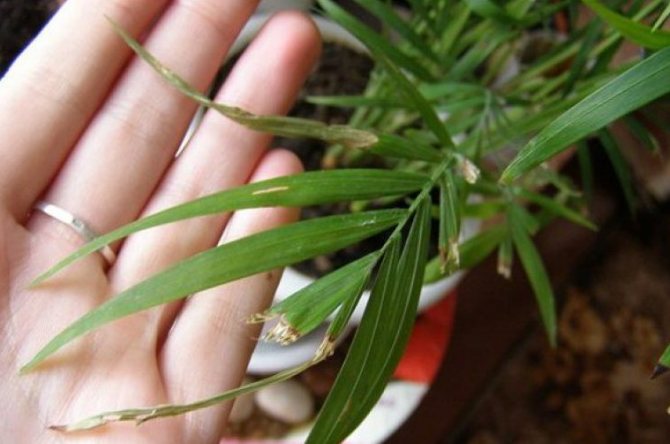

It should not be excluded from possible problems and the defeat of the palm tree by diseases and pests, among which spider mites, aphids, scale insects and mealybugs are especially active, often causing a change in the color of leaves, the appearance of characteristic cobwebs and spots. In this case, only specially developed chemical compositions (for example, Actellik) will help to solve the problem.
As for possible ailments, chamedorea elegans is often overwhelmed by fungal infections that cause yellowing and leaf fall, decay of the root system. In case of partial infection, fungicidal preparations ("Homecin" or "Kuprozan") and transplanting the plant into a new substrate will help to rid the palm of the fungus. If the fungus has damaged most of the rhizome, then the palm cannot be saved.
Hamedorea: home care. In detail
In order for the palm tree to grow well, it is necessary to provide proper care for the chamedorea in an apartment or house. Consider the features of growing this plant.
Bloom
The peculiarity of this palm tree is that it has been blooming since the 3rd year. If you plant several plants in a pot, they will bloom in turn throughout the year. Delicate yellow flowers with a pleasant aroma resemble mimosa.
In young plants, it is recommended to remove the peduncle, because the plant spends a lot of energy and will grow poorly. Fertilizing will correct the situation.
Temperature regime
It reacts especially to high temperatures, so in the summer you should ventilate the room. In winter, the plant should be in a room with a temperature in the range of 12-18 ° C, excluding drafts and hypothermia. But even in critical conditions, the plant is able to survive.
Spraying
The optimum humidity for a palm tree is about 50%. When growing a plant at home, it is recommended to spray it once a day with settled water. Some growers claim that the palm tree can be sprayed a couple of times a week, and in winter, one spray per week is enough.
But even if the plant is not sprayed, it will not stop growing, however, the likelihood of being hit by a spider mite increases.
Lighting
The plant is considered one of the most shade-tolerant plants. A pot with a palm tree is best placed near the east window. This is an ideal option for landscaping a room where there is little sunlight. With too much light, the leaves of the palm tree may turn yellow, and the plant itself will weaken.
Hygiene
To keep the leaves clean, it is necessary to periodically arrange a shower for the palm tree. If the plant is large, it is thoroughly sprayed.
Watering
This plant should be watered abundantly in summer, preventing the soil from drying out in the pot. Homemade chamedorea is demanding on soil moisture, so it is watered 2-3 times a week.It should be remembered that overflow is harmful for a palm tree.
In winter, the frequency of watering is reduced to 1 time per week, which will avoid root decay.
Pot
There is no unequivocal opinion on the choice of a pot: some recommend replanting a palm tree in a spacious container, while others believe that the pot should be cramped, so you need to transplant it into a container of a slightly larger diameter.
Priming
As part of the substrate, 3 parts of it are sod land, which has a high density. Add 1 part of leafy earth, sand and peat to it. The acidity of the soil should be in the range of 5-6.5.
It is recommended to use "Palm" from the ready-made potting mix, adding a little sand.
Top dressing and fertilization
In the summer, they are fed with a universal fertilizer (for example, Agricola) every 2-4 weeks. Only pre-dressing is bred in half with water. In winter, you do not need to feed the palm tree.
Transfer
Young plants should be transplanted into a larger pot each year. A mature hamedorea transplant is carried out when the roots are visible from the hole in the pot. That is, the procedure is carried out approximately once every 4-5 years. Since an adult palm is difficult to transplant, you can only renew the topsoil by replacing it with fresh substrate.
Pruning hamedorea
If large brown patches appear on the leaves, such shoots should be cut off. You also need to remove dry and yellowed leaves, cutting to living tissue. Pruning is carried out with sharp scissors, having previously treated them with alcohol. The cut sites are treated with a fungicide.
Some growers recommend removing peduncles from young plants so that the palm tree will grow well in the future.
Dormant period
The basic rule for caring for a palm tree during the dormant period is the absence of fertilizing, rare watering, and a decrease in the temperature in the room. The plant is rarely sprayed in winter.
Where is the best place in the house?
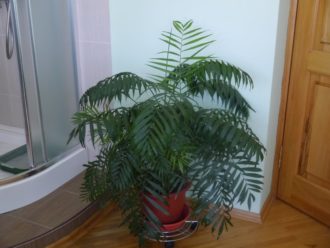

If space permits, such a plant is best placed in the hallway so that it cleans those entering the house from the negativity that they could bring with them.
In addition, at the energy level, the palm tree chamedorea personifies movement, so it can be placed at the patient's feetwho has problems with the musculoskeletal system. Again, you cannot keep it there all the time, but it is better to leave it for a couple of hours, and then take it back to a place where it will not affect the living. These can be south, northeast, southeast and northwest rooms.
Chamedorea will show itself perfectly where sharp corners of buildings, monuments or arrows of tower cranes are directed to the dwelling.
Growing from seeds
Fresh seeds are selected for sowing, since their germination rate decreases by 10% every month. That is, the seed packing date should be no older than 10 months. If your home has a palm tree of both sexes, you can manually pollinate the flowers and get your own seeds.
Seeds are soaked for 5-6 days before planting, having removed first saw off the hard shell with a file or a sharpening stone. Each seed must be sown with the sawn part down into a separate glass, into which the peat-sand mixture is poured.
It is not necessary to sprinkle the seed with earth; the glass is placed in a greenhouse to ensure a greenhouse effect. Periodically, the shelter is ventilated, the soil is moistened. After 2 months, shoots will appear from home seeds, and from purchased ones - in 6-8 months. When the leaf grows to 4 cm, the seedlings can be replanted.
Feng Shui meaning
According to the Eastern teachings, hamedorea is able to absorb flows of positive energy from the surrounding world and enrich her place of residence with them. Therefore, spiritual practitioners love to meditate and seek enlightenment next to the flower.
If you correctly position the palm tree according to the theory of feng shui (career zone, zone of luck), then success in work will not be long in coming.
According to the ancient teachings, chamedorea combines the energy of metal and wood, so the plant cannot be called harmonious. However, in spite of everything the flower copes well with negative energy.
Diseases and pests
When growing, some problems may arise:
- Dry leaf tips hamedorea is a sign of dry air. It is necessary to regularly ventilate the room, spray the palm tree.
- Leaves turn yellow - excess lighting or watering with hard water. The plant should be rearranged to a darker place and soft water should be used.
- They droop, die off, the leaves rot - usually this happens in winter due to rotting of the roots of the palm tree. The reason for this is excessive watering of the plant. To remedy the situation, you need to reduce the frequency and volume of irrigation, loosen the soil. You can make a transplant by cutting off rotten roots, and add drainage, moisture-retaining components (sphagnum or coal) to the soil.
- Brown spots on the leaves - a sign of over-watering the palm tree or using too hard water. You need to cut off damaged leaves, reduce watering, use soft water.
- Leaves wither and darken - the consequences of keeping at low temperatures. Move the plant to a warmer room.
- The lower leaves are falling Is a normal process for mature palm leaves. Such leaves are cut off and the cut sites are processed.
- Cotton-like bloom on the leaves - this is a sign of the appearance of a mealybug on the plant. You will need to treat the bush with insecticides.
Pests that can attack: mealybug, spider mite, scale insect.
Choosing a place for a flower
Hamedorea not suitable for growing on a windowsill, therefore, before buying, you need to find a suitable place for it in advance. This could be:
- the area in front of the window or to the side of it;
- free, sufficiently lit corner;
- low cabinet or flower stand.
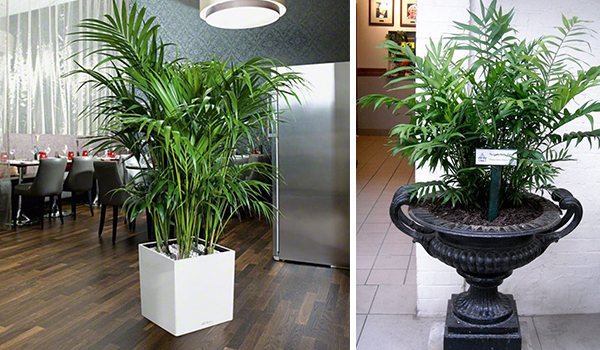

Hamedorea grows well in both natural and artificial light. The best option is when scattered sunlight falls on the plant during the day. But if the flower is in the far corner of a room or dark hallway, then next to it it is necessary to place a fluorescent or LED lamp, which should work at least 10-12 hours a day.
Owners of rooms with south-facing windows should make sure that in the summer, direct sunlight does not fall on the palm tree from 10 to 17 hours. Hamedorea should be moved away from the window or deeper into the room so that the scorching sun does not leave burns on the leaves in the form of ugly brown stains. In winter, the flower can be moved closer to the window, since the sun's rays are safe at this time of year.
Council number 2. With one-sided lighting, the symmetry of the hamedorea is violated, and the bush eventually loses its natural attractiveness. To prevent this from happening, the flower pot must be rotated around the axis. For example, make a 90-180 degree turn every week.
Types of homemade hamedorea with photos and names
The most common types are:
Hamedorea graceful (Chamaedorea elegans)


It is a perennial single-stemmed plant up to 1.5-2 meters high. 6-7 plumose leaves develop on a smooth trunk. Each leaf is divided into 8-15 dark green narrow-lanceolate segments. Inflorescence - loose panicles of cobs, which are formed by orange-red flowers. After flowering, black berries are formed.
Chamaedorea Ernesti-Augusti
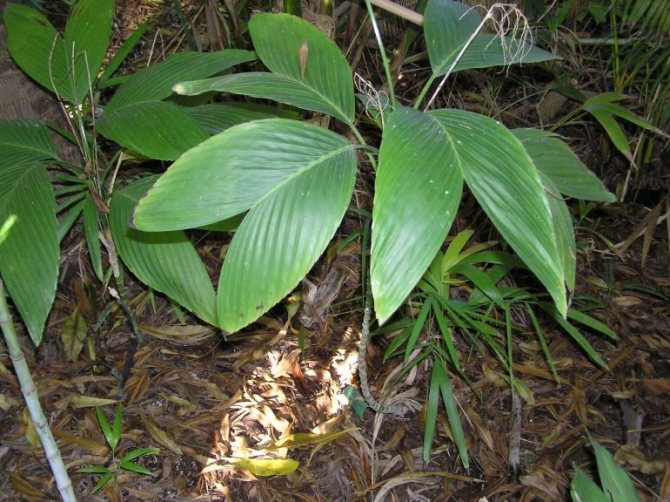

In this species, the leaves are dark green, not segmented. The leaves are distinguished by a large, wide plate, which sometimes divides in two at the end. It grows slowly. The form of the plant is stem - one stem grows from one rhizome. It blooms with red spherical flowers, collected in spreading inflorescences.
Hamedorea high (Chamaedorea Elatior)
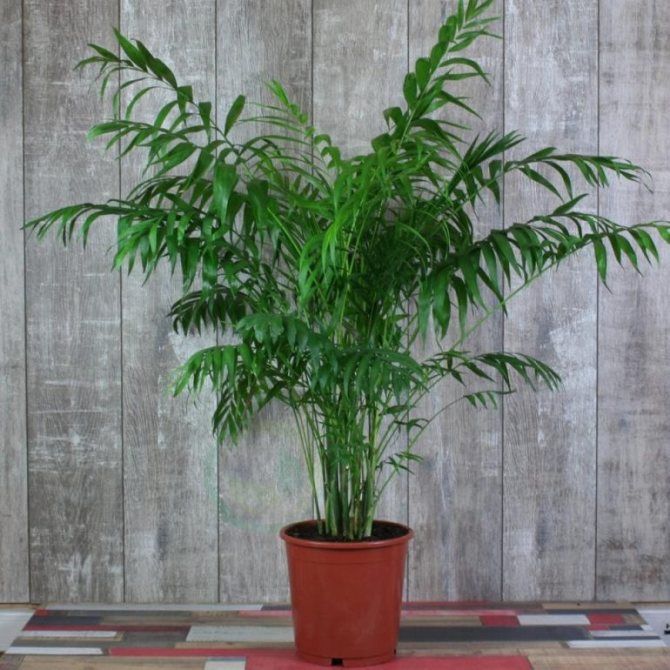

Stems are tall, erect, outwardly resembling bamboo stems. After the bottom leaf falls off, a light ring remains on the stem.The top of the stem is crowned with 4-6 dark green leaves of a pinnately dissected shape. The narrow-lanceolate lobes have a pointed edge. It blooms with bright orange flowers gathered in panicles.
Hamedorea one-color (lat.Chamaedorea Concolor)
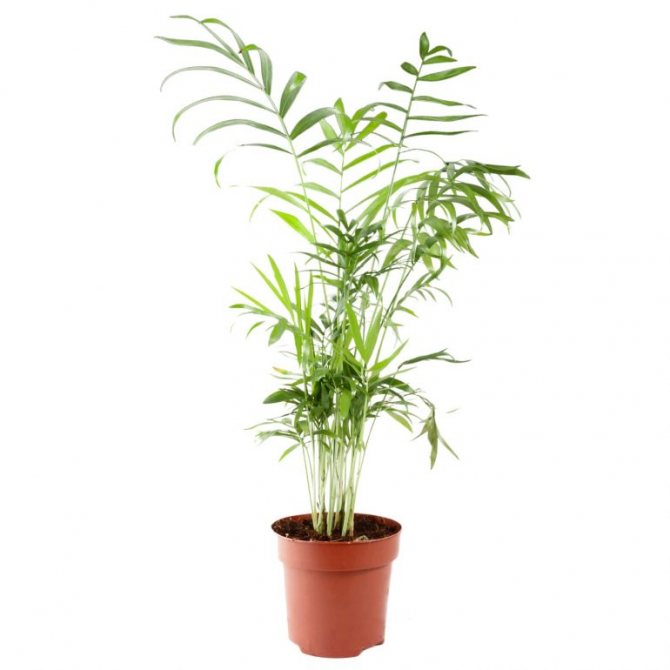

The most unpretentious view. Shoots grow slowly, no higher than 1 meter in height. The form of the plant is bushy due to the formation of several thin shoots. At the top of the shoot are light green leaves of a pinnately dissected form. Flowering in this species comes quickly - paniculate inflorescences of a yellowish tint appear on young plants.
Description of the Hamedorea palm
Chamaedorea is a very beautiful plant. It can grow up to 2 meters in height in its natural environment, but indoor species are usually much smaller. The leaves grow 30-60 cm, depending on the age of the palm. Young twigs are light green, but over time they become more saturated, green color. The life span of a culture is not less than 5 years, and under the right conditions it is much longer.


Hamedorea in nature can grow up to 2 m in height
Important!
Chamedorea grows very slowly - this is a feature of the indoor palm, so it is pointless to wait for active growth, even with fertilization. She can give only 2-3 new branches per year!
The palm tree produces very unusual flowers. The peduncle is a green twig covered with small flowers. In appearance, the flower resembles a mimosa - it contrasts pleasantly with the green foliage. The scent can be strong or weak, depending on the type of flower. After the inflorescences, small fruits appear, resembling berries.
What you need to know when buying Hamedorei (Neanta)?
When purchasing a Neantu in a store, you must carefully examine the proposed copy. A healthy palm should have bright foliage, new growths. If there is a brown tint at the tips of the leaf blades, such a specimen must be discarded.
Large Hamedorea has a high price tag. This is due to the fact that the palm tree grows extremely slowly. Often in stores they offer to purchase a container with a large number of seedlings, which together form a very beautiful bunch. Often, after purchase, after some time, the seedlings will begin to dry out, as they will become cramped in one pot. The situation can still be corrected by dividing, after some time, as soon as the seedlings begin to wither, the bush into several parts. Weak, drying out sprouts are best removed, leaving only strong and healthy ones.
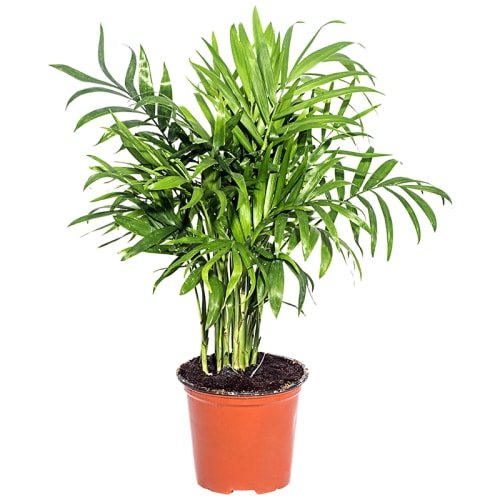

Hamedorea Bridble
Transplant rules
Young specimens must be transplanted annually in the spring, an adult palm is transplanted only if the root system is cramped in the pot. You can understand this if the roots stick out the plant itself from the ground.
Pot selection
For the transplant procedure, a pot is selected, the volume of which will be slightly larger than the previous one. It is desirable that the container remains the same width as the previous one, but deeper. The pot must have a drainage layer.
How to transplant?
Hamedorea has a hard time transferring, and therefore if this is a planned procedure, then the bush is transshipped, that is, without destroying the earthen coma. But if the roots are damaged by rot, which can be caused by excessive soil moisture, then in this case, the root system is freed from the ground, washed, diseased roots are removed, sprinkled with charcoal, and then planted in a new pot with fresh soil.
Soil mixture
The substrate for growing Hamedorea can be purchased in a specialized store or you can prepare it yourself.
- It is necessary to take two parts of sod land, humus, peat and one part of sand.
- Mix humus, leafy and coniferous soil in equal proportions.
In order for the substrate to be light, loose, it is necessary to add sand, vermiculite or coconut chips to it. You can also add charcoal.
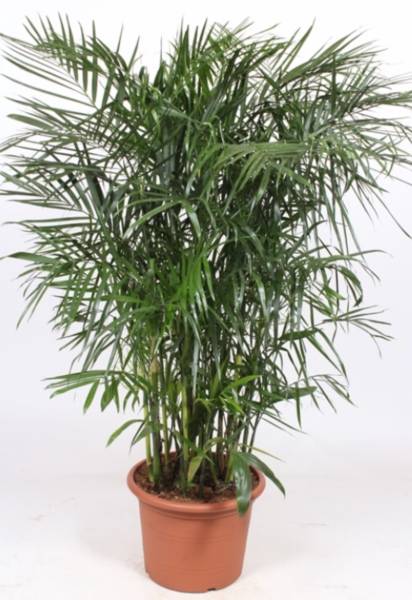

Hamedorea Seyfrizi
Reproduction
There are two ways to propagate hamedorea elegance at home:
- seeds harvested from berries or store-bought seeds;
- dividing an adult bush.
The easiest way is vegetative propagation by dividing the bush. For this, adult plants are used, which have several well-developed stems and a powerful root system. It is convenient to combine reproduction with a transplant, which is best done in May. You need to do it like this:
- Prepare two sized pots.
- Place drainage material on the bottom and some palm soil on top.
- Remove the bush from the old pot and divide it in two. Each of them must have at least one developed stem and several healthy roots.
- Place each of the bushes in its own pot and, holding them with your hand, cover the remaining space with soil.
- Lightly compact and moisten the soil, and sprinkle it on top with a thin layer of dry soil.
If the bush is still too small to reproduce by dividing, or there is none at all, then the only way to grow a palm tree is to plant its seeds. But this should be done immediately after the ripening of the fruit, since the germination of the seeds decreases rapidly.
Step-by-step description of chamedorea propagation by seeds:
- Soak palm seeds in water and place in a warm place for 5 days. Make sure they have access to air and that they remain wet at all times.
- Prepare your potting mix. It is best prepared from leafy earth, adding 1 part of perlite or vermiculite to it. Heat it on a baking sheet in the oven for 2 hours.
- Fill the seedling cups with soil.
- Remove the seeds and gently break the shell. So they will germinate faster.
- Press one seed into each glass, but do not deeply deepen: they should only be slightly powdered with soil.
- Moisten the soil and place all the cups in one tray.
- Cover them with a plastic bag or glass to create a mini greenhouse. The temperature in it must be at least +27 ° C.
- Place the pallet in a well-lit place, but not in direct sunlight.
- Ventilate the mini-greenhouse daily, remove all condensation, and, if necessary, moisten the soil.
- The first shoots will appear no earlier than 1-1.5 months. And especially patient growers can wait for sprouts for 8-9 months at all (and this may be). During this time, it is important to maintain high humidity and high temperatures.


After the emergence of seedlings, the film is removed and they are waiting for the plant to reach a height of 4-5 cm. Then the seedlings are planted in small pots. If you want to get dense palm growth, then you can plant several seedlings in one bowl. Further care should be the same as for an adult plant.
1. Seven Secrets of Success:
| 1. Growing temperature: in spring and summer, when chamedorea is actively developing, it needs warm conditions - keep palm trees at air temperatures ranging from 18 to 24 degrees Celsius. During the winter months, it is best to provide a cool dormant period of 13-15 degrees Celsius. |
| 2. Lighting: shading from direct sunlight only during the daytime - in the morning and evening, plants can take sun baths. With a lack of natural light, chamedorrhea develops well under artificial lighting. |
| 3. Watering and humidity: soft water at room temperature, watered in such a way that between waterings the top layer of soil 2-4 cm thick dries slightly in spring and summer. In the fall and winter, keep watering frequency to a minimum, just being careful not to dry out the clod. Air humidity is high. |
| 4. Pruning: palm trees only need sanitary pruning, which removes all old and diseased leaves. In order for the palm tree not to waste its energy on flowering and fruiting, only the peduncles that have appeared are cut off. |
| 5. Priming: loose, well-drained, nutritious substrate with neutral to slightly acidic pH. |
| 6. Top dressing: from spring to autumn, regular fertilizing with mineral liquid fertilizers for palms or decorative leafy plants every 2 weeks. In mid-autumn, the subcortex stops and resumes only in spring, with the first signs of new growth. |
| 7. Reproduction: by sowing seeds in spring or by dividing large specimens when transplanting, by root suckers in spring and summer. |
Botanical name: Chamaedorea.
Hamedorea home - family... Areca or Palms.
Homeland of the plant... Mexico, Guatemala.
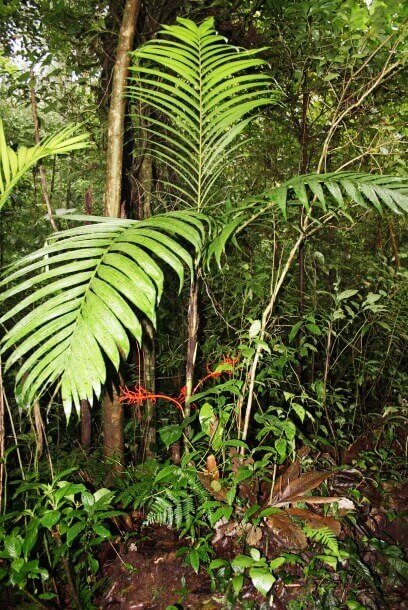

Description... Evergreen low palm with several thin, graceful trunks.
The crown is formed by lush, feathery, complex leaves up to 60 cm long, consisting of many alternately located narrow-lanceolate segments.
Segments leaves are glossy, green, 10 - 15 cm long, with longitudinal parallel venation. The edges of the leaf segments may be forked in some species.
Inflorescences branched, drooping or erect, composed of numerous yellow flowers... There are male and female flowers on different plants - that is, these palms are dioecious plants.
On female palms, after flowering, small rounded fruit.
In some types of chamedorrhea, in the lower part of the trunk, with age, aerial roots.
The second name is bamboo palm, the plant received for the external similarity of thin, graceful stems with bamboo shoots.
↑ Up,


Height... Hamedorea palm tree grows at home slow and in a pot culture often does not exceed 1m.
In their natural habitat, these trees can grow up to 5 m. In height.
There are miniature varieties, the height of which, when grown in pots, reaches only a few tens of centimeters.
↑ Up,


Fertilizer
Chamedorea needs feeding from April to September twice a month. It is important to consider that young and recently transplanted chamedoreas should not be fertilized for the first six months.
For feeding, liquid or granular complex fertilizers are used for decorative leafy flowers or special ones for palm trees.
Young, recently transplanted chamedoreas are not fed for 6 months.
It is not recommended to fertilize the plant in winter., since stimulation of growth in cold weather with a short daylight hours contributes to the formation of weak, elongated shoots. And this spoils the decorative appearance of the palm tree.
In addition to root dressing, it is recommended to use leaf spraying from time to time. For this purpose, fertilizers are diluted at a concentration 2-3 times weaker than indicated on the package.
Chamedorea responds well to granular fertilizers of prolonged action.
Watering
Hamedorea is a moisture-loving plant, but it does not tolerate waterlogging very well. Therefore, in the summer, watering should be regular, but moderate.
The signal that the next humidification of the chamedorea is needed is a slight drying out of the top layer of the soil.
In winter, watering is significantly reduced. The earthen lump should dry out by 3-4 cm before watering.
Under no circumstances should the soil in the pot be damp or waterlogged. Waterlogging can lead to rotting and death of the plant. The water remaining in the sump must be drained 15-20 minutes after watering.
Water for irrigation should be warm and settled.
General information
Palm trees dispel pessimistic and melancholic mood, set a cheerful mood, it is best to settle a palm tree in the living room, in the bedroom - it is not recommended. Can I keep it at home? Signs - a container with a palm tree should not be brought into the apartment, trouble is possible. To avoid this kind of negativity, they are imported in a wheelchair. But this is everyone's personal business - to believe or not.
The palm tree is not demanding on leaving conditions. For this reason, apartments are in demand among residents. The species diversity of chamedorea is wide, but only a few of them can be grown in a room setting.Each is endowed with its own personality.
Landing
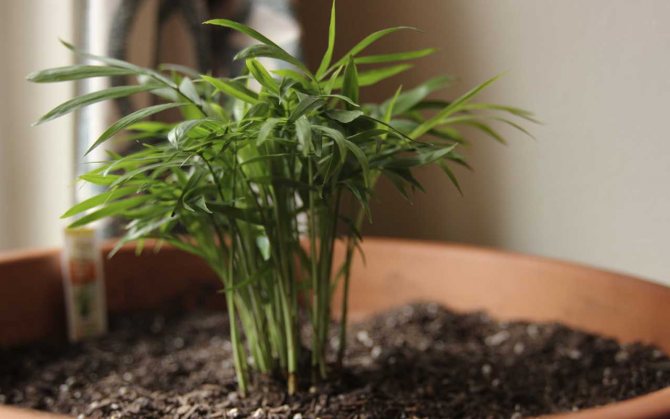

Young escape of hamedorea
Usually very small sprouts of Hamedorea are planted (for example, when buying in a store).
For planting, you will first need a small pot, only 1-2 cm larger than the previous one in diameter, since this palm tree grows slowly. It is necessary to count on the fact that at least a quarter of the height should be drainage.
By the way, it is highly undesirable to completely free the root from the old soil. From this, the entire bush can die.
New soil should either be bought ready-made (for palms), or prepared from the composition of sod land (2/3) and humus with leafy soil (1/3).
Brief description of the plant
Hamedorea graceful is a species belonging to the genus Hamedorea of the palm family. Chamaedorea elegans naturally grows in the dense rainforests of Mexico and Guatemala. Accordingly, for growing at home, it needs a warm and humid microclimate.
The hamedorea elegance palm tree reaches a height of 1.5-2 m. It is a rhizomatous shrub with a vine-shaped trunk, from which thin, erect stems, similar to bamboo, extend. Their upper part is a panicle of 6-7 long-petioled bright green leaves. They consist of 12-15 pairs of almost crescent-shaped fragments, reaching 15-20 cm in length.
After gradual natural withering away, they leave ring-shaped light marks on the stem. Peduncles, appearing from leaf sinuses, bear paniculate loose inflorescences, consisting of spherical small yellow flowers, partly similar to mimosa. After the end of the flowering process, round fruits are formed with a diameter of no more than 6 mm with one seed inside. When fully ripe, they turn black.
All types of hamedorea, including the graceful one, are dioecious. For propagation by seeds, it is necessary to have plants of both genera.
What an elegant palm tree looks like
Hamedorea elegance is called graceful for a reason - it looks like a compact bush with straight stems emerging from a creeping trunk. Arched narrow long leaves, the number of which reaches 10 pairs, give a special sophistication to the palm tree. In the fourth year of life, the plant begins to form rounded yellow flowers that resemble mimosa.


Hamedorea with its long green leaves will go well with any other plants on the site
Hamedorea lives for 8–9 years, during which time an adult plant is able to reach two meters in height. However, such giants are quite rare, usually at home a bamboo palm tree does not grow more than one meter.
Trim / Support / Garter
From time to time, chamedorea needs sanitary pruning. Sick, yellowed and dried leaves are removed. To do this correctly, you must follow some rules.
Pruning shears or garden shears are used for pruning. In order not to bring infection or disease to the cut site, the instrument must be thoroughly disinfected with alcohol before the procedure.
All unnecessary leaves are trimmed to young tissue as close to the base of the stem as possible... This will help prevent the spread of infection through the plant if the cut leaf is diseased. After trimming, the sections are recommended to be treated with fungicidal preparations.
It is important to remember that leaves that are just beginning to turn yellow should not be cut off. They can still be saved thanks to proper care and the necessary conditions of detention.
Sanitary pruning of leaves is done as needed.
Where and how it grows


Where hamedorea grows: photos in nature were taken most often under the dense shade of tropical trees. The Elegance species tolerates shade well, easily adapting to the conditions of the greenhouse or to the windowsill on the north side.
The natural habitat of the plant is the dense humid forests of Madagascar, Mexico. Some cold-resistant hamedorei species grow in southern Europe, on the Black Sea coast, in the Caucasus.
Application


Hamedorea graceful refers to highly decorative indoor plants. It is unpretentious in terms of lighting, it blooms beautifully, it is not difficult to keep it at home. The owner of a plant with a height of 30 cm will be able to boast of a photo of a blooming palm tree.
Hamedorea is used to decorate rooms. Thanks to its shade-loving nature, the palm tree will feel good even in the back of the room, away from windows. Therefore, the plant is perfect for landscaping (design) interiors.
Varieties
There are several varieties of hamedorea that are grown at home. They are very similar in the way they grow and care, however, they have some differences in appearance and small features in growth and development.
Consider the most popular varieties of homemade hamedorea:
back to menu ↑
Read also: Begonia - home care and reproduction (120 Photos & Videos) + Reviews
Hamedorea graceful
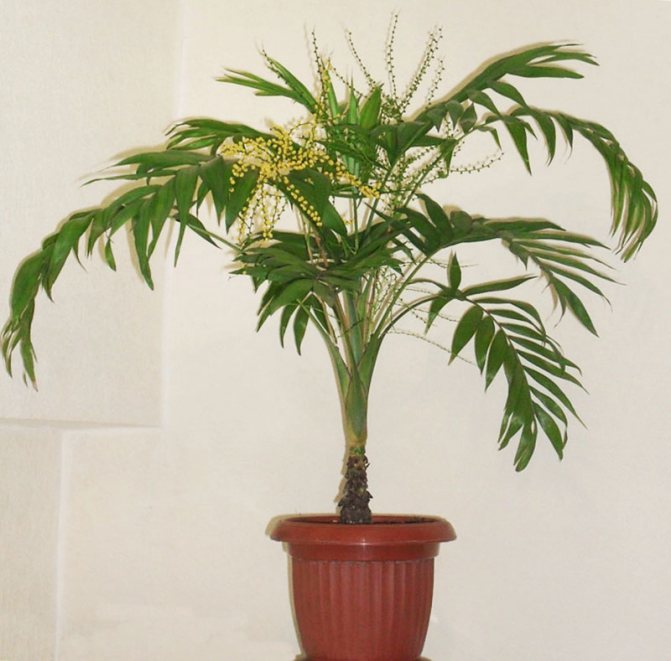

Hamedorea graceful
- It is the most popular in the post-Soviet space, since it appeared here one of the first. This is a relatively small plant with a maximum growth of no more than one and a half meters.
- It has feathery leaves, for which a characteristic feature is the ability to bend. These leaves-arcs can be from 50 to 100 cm in length.
- They fit tightly to the trunks, the number of which is small.
- The plant cannot boast of a beautiful flowering. Inflorescences are peculiar panicles, at the ends of which are yellow spherical flowers.
- Sometimes their shade can reach yellow-green, and the petals are velvety.
- As noted earlier, it is recommended to get rid of the peduncles so that the plant does not waste resources on essentially useless flowering, but uses them to grow and increase the number of shoots.
back to menu ↑
See also: Dieffenbachia: a description of 12 varieties for growing at home, features of care, transplantation and reproduction + Reviews
Hamedorea high


Hamedorea high
- This variety fully lives up to its name.
- With proper care, chamedorea tall can grow from 3 to 5.5 m.
- Growing upward, the plant loses its leaves and they, leaving marks on the trunk, make the trunk very similar to a bamboo plant.
- In fact, this variety is a long stem with 5 to 7 large leaves growing on top.
- The flowering, as well as that of the graceful hamedorea, is discreet, but the color is slightly different - instead of yellow, it is orange.
Is it possible to keep chamedorea at home
Hamedorea belongs to the palm family. Some of them are poisonous, so people are wary of all palms.
Hamedorea cleans the air of harmful substances and neutralizes negative energy. It is perfect for offices, relieving the atmosphere in the team. By suppressing conflict and making people positive, hamedorea improves the morale of all workers.
At home, the palm tree refreshes the air and pacifies the owners, allowing them to relax and unwind.
The plant is recommended for people who often experience depression and melancholy.
For city dwellers, the palm tree will be a salvation from dangerous impurities in the air:
Hamedorea in the house is replaced by an air purifier.
Bloom
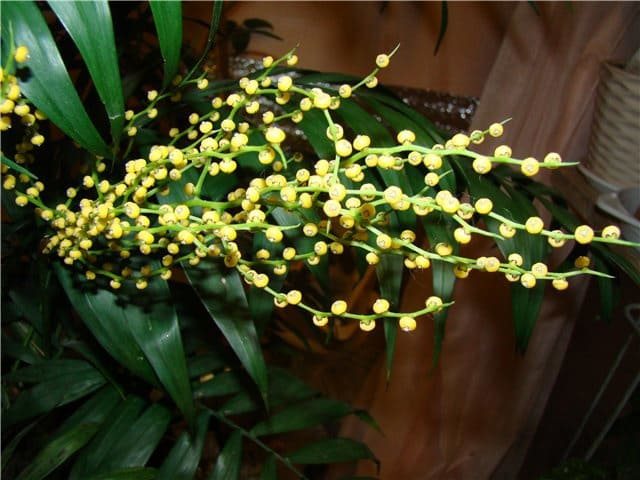

Chamedorea flower differs in palms of the same variety. In males, the inflorescence resembles a panicle or beads strung on a twig. Ladies will sprinkle more fragrant and beautiful buds. The color is brighter in the latter, it is close to orange or red, male flowers are often yellow.
In most varieties, buds appear for the first time 5-6 years after planting. The Ernest-Augusta variety blooms more often with proper care every year. Pay special attention to the dormant period, the more careful the care is, the faster new flower stalks will form.
Lighting
Hamedorea is one of the most shade-tolerant plants. It grows and develops better in moderate lighting than in bright light.
The best place for hamedorea will be north, east or west windows.
Also, a bamboo palm tree can be placed in the back of the room, opposite a window facing south or east.
Hamedorea does not tolerate direct sunlight.
From straight lines better than the sun, palm leaves may begin to turn yellow and fall off. Therefore, when choosing a place, it is important to take this fact into account and give preference to partial shade.
In order for the crown to grow and develop symmetrically, the pot with the plant must be rotated around the axis 2-3 times a month.
Temperature
Hamedorea loves warmth... In summer, it feels comfortable at 20-26 degrees.
Higher temperatures will not negatively affect the plant if the humidity is high.
In winter, the optimum temperature for hamedorea will be 16-18 degrees.
It is important to ensure that the temperature of the soil does not fall below the indicated level, as this is fraught with disease of the root system.
It is important to protect the bamboo palm from drafts and sudden temperature changes. She loves fresh air. Therefore, the room in which it is located is recommended to be regularly ventilated. When it's warm outside, you can take it out onto the veranda, balcony or garden.
Spraying
In summer, chamedorea should be sprayed 2 times a day, morning and evening, with warm water. This will not only create favorable conditions for growth, but will also prevent the appearance of spider mites.
On especially hot days in Hamedorea, you can have a warm shower.
In winter, when the temperature of the content drops below 20 degrees, spraying should be stopped to avoid fungal diseases. However, if the indoor air is dry, spraying should be done from time to time.
Houseplants Directory
Can Chamedorea be transplanted immediately after purchase? Read today's article to determine the timing of the transplant and move the plant correctly.
How to transplant chamedorea after purchase?
Mexican plant, palm tree chamedorea - every year more and more flower growers join the group of hamedorea lovers, considering it one of the most attractive and sophisticated for the home.
- Compact size, like for a palm tree - from 2 to 2.5 m.
- Standard room temperature is 22 ° C.
- Shade tolerance.
- Using the available ingredients for the soil mixture.
The only thing that the florist has to put up with is the increased air humidity (50-60%), but additional sprays save the day.
Unlike flowering plants, transplanting chamedorea immediately after purchase is acceptable - no need to wait for a specific period in development to transplant. A few care points to look out for: choosing the right transplant mix, choosing the pot and grooming system.


How to transplant chamedorea after purchase:
- Substrate of 1 part of sand, 1 part of peat and leafy soil + 3 parts of peat.
- Reduce watering the day before transplanting.
- Transfer from the old pot to the new one.
- Repeat the transplant every 3 years.





